外研版(2019)必修 第一册Unit 5 Into the wild Developing ideas 课件(共19张PPT)
文档属性
| 名称 | 外研版(2019)必修 第一册Unit 5 Into the wild Developing ideas 课件(共19张PPT) | 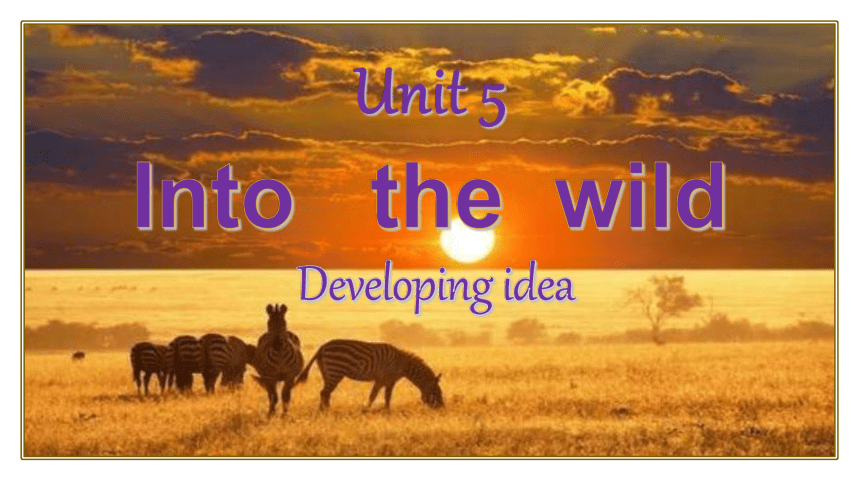 | |
| 格式 | pptx | ||
| 文件大小 | 69.9MB | ||
| 资源类型 | 教案 | ||
| 版本资源 | 外研版(2019) | ||
| 科目 | 英语 | ||
| 更新时间 | 2022-11-14 16:21:41 | ||
图片预览

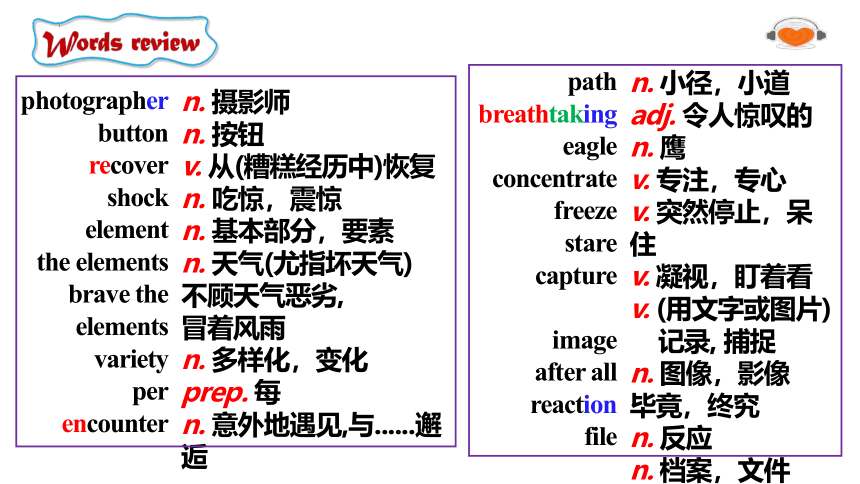
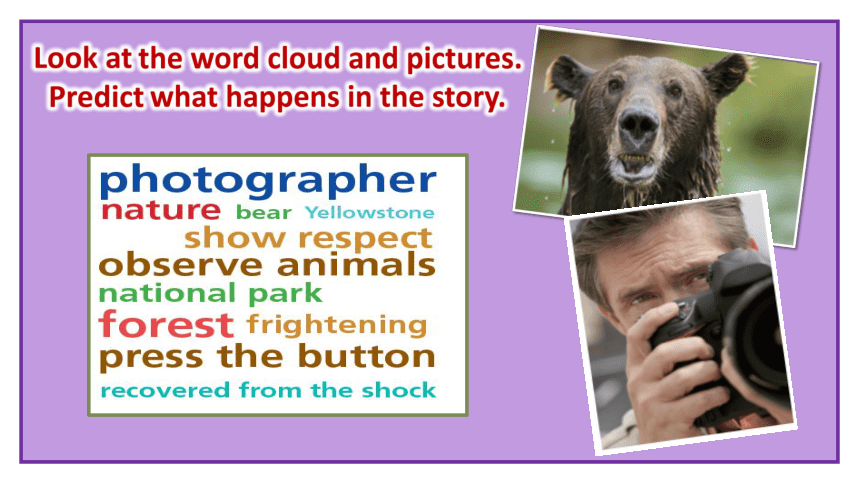
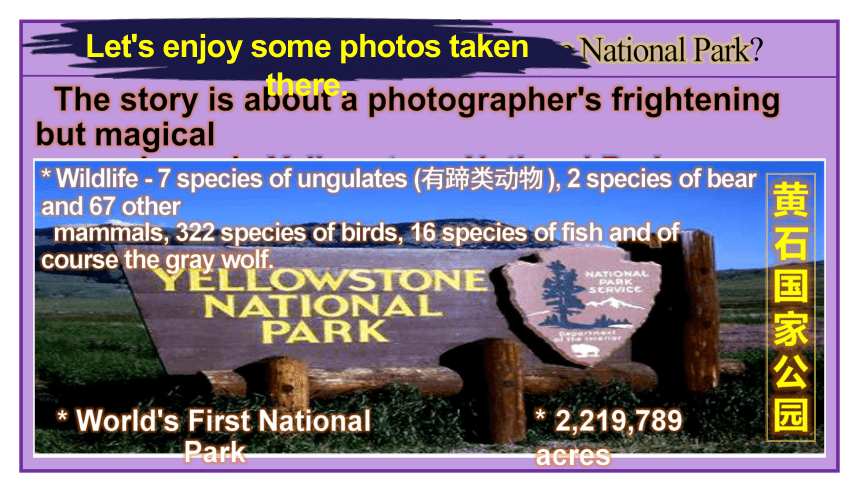
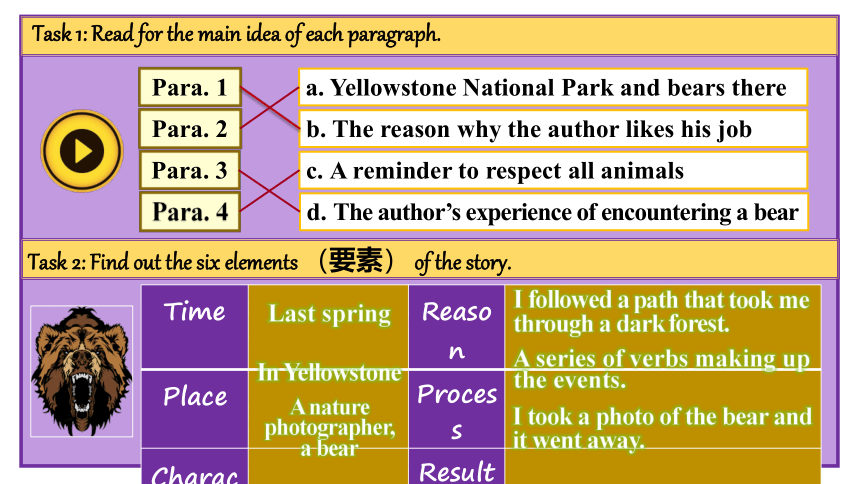
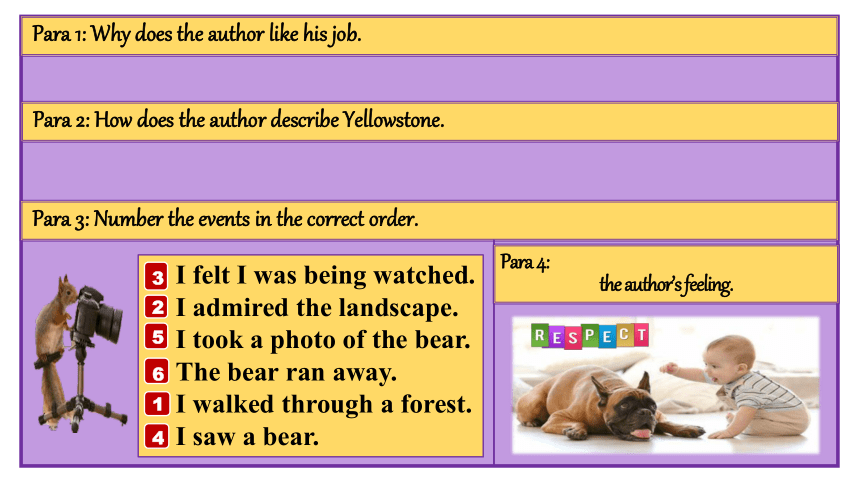
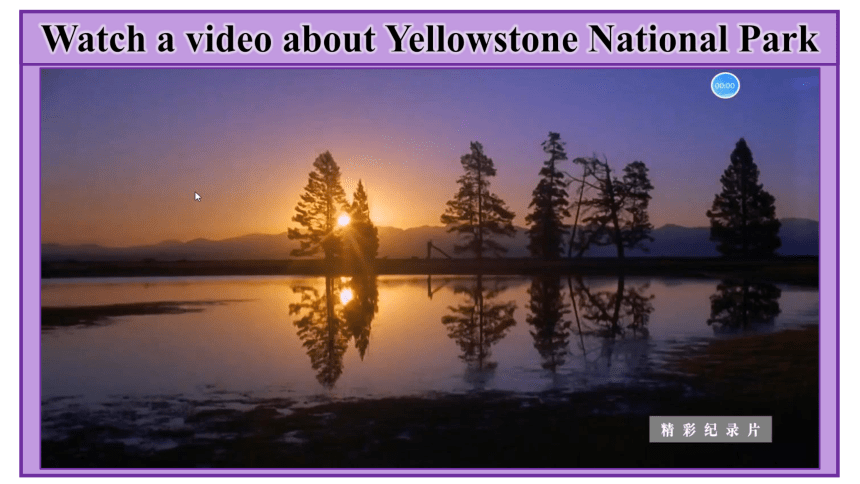
文档简介
(共19张PPT)
Unit 5
Into the wild
Developing idea
photographer
button
recover
shock
element
the elements
brave the elements
variety
per
encounter
n. 摄影师
n. 按钮
v. 从(糟糕经历中)恢复
n. 吃惊,震惊
n. 基本部分,要素
n. 天气(尤指坏天气)
不顾天气恶劣,
冒着风雨
n. 多样化,变化
prep. 每
n. 意外地遇见,与......邂逅
path
breathtaking
eagle
concentrate
freeze
stare
capture
image
after all
reaction
file
n. 小径,小道
adj. 令人惊叹的
n. 鹰
v. 专注,专心
v. 突然停止,呆住
v. 凝视,盯着看
v. (用文字或图片)
记录, 捕捉
n. 图像,影像
毕竟,终究
n. 反应
n. 档案,文件
Look at the word cloud and pictures.
Predict what happens in the story.
Read the passage and check your prediction.
The story is about a photographer's frightening but magical
experience in Yellowstone National Park.
What do you know about Yellowstone National Park
Let's enjoy some photos taken there.
黄石国家公园
* Wildlife - 7 species of ungulates (有蹄类动物 ), 2 species of bear and 67 other
mammals, 322 species of birds, 16 species of fish and of course the gray wolf.
* World's First National Park
* 2,219,789 acres
Task 1: Read for the main idea of each paragraph.
Para. 1
Para. 3
Para. 4
Para. 2
a. Yellowstone National Park and bears there
b. The reason why the author likes his job
c. A reminder to respect all animals
d. The author’s experience of encountering a bear
Task 2: Find out the six elements (要素) of the story.
Narration
Who
How
What
Why
Where
Characters
Plot
Setting
Events
When
Time Reason
Place Process
Character Result
Last spring
In Yellowstone
A nature photographer,
a bear
I followed a path that took me through a dark forest.
A series of verbs making up the events.
I took a photo of the bear and it went away.
Para 1: Why does the author like his job.
Para 2: How does the author describe Yellowstone.
Para 3: Number the events in the correct order.
I felt I was being watched.
I admired the landscape.
I took a photo of the bear.
The bear ran away.
I walked through a forest.
I saw a bear.
3
2
5
6
1
4
Para 4:
the author’s feeling.
Watch a video about Yellowstone National Park
Read the sentences from Paragraph 3 and work out the meaning of the words in bold.
1.When I finally stepped out of the trees, the view was breathtaking.
2. An eagle flew over the snow-capped mountains, which were reflected in
the still lake below.
3. My most frightening but magical experience was now captured forever in
a single image.
Guessing tip: When you read an unfamiliar word, make sure that you read the whole sentence. Try to work out what type of word it is (noun, adjective, verb, etc), then use the words before and after it to help you guess the meaning.
“Breathtaking” means something is extremely beautiful or amazing, often in a surprising way.
“Reflected” means that images can be seen on the surface of the mirror, glass or water.
“Frightening” means that something is making people feel afraid, anxious or nervous.
How would you react if you were in the same situation as the photographer
What can we do to show our respect for animals
Think & Share
If I were in the same situation as the photographer, I might run away from the scene immediately. But it is dangerous. I might be also extremely frightened but I would try to keep calm.
Animals are our friends. We live together in one world. The way we treat animals is to show our respect for animals. We should protect the wild habitat.
I see hill on hill all in red
And wood on wood in a deep dye
The river green down to the bed
In speed a hundred barges vie
Far and wide eagles cleave the blue
Up and down fish in shallows glide
All creatures strive for freedom under frosty skies
看万山红遍,层林尽染;漫江碧透,百舸争流。
鹰击长空,鱼翔浅底,万类霜天竞自由。
——毛泽东 《沁园春·长沙》
This is the life we should have tomorrow.
Give a talk about a job that involves working with animals.
Refer to the table below to help plan your talk.
Job description Wildlife photographers aim to photograph animals in their natural habitats.
Job requirements Being a wildlife photographer requires good photography skills, knowledge of animal behaviour and a lot of patience.
Rewards of the job Wildlife photographers have the opportunity to see animals in the wild and help improve people’s understanding of them.
Group Work
Important phrases
1. brave the elements _______________
2. take photos _______________
3. be famous for _______________
4. at a speed of _______________
5. concentrate on _______________
6. recover from _______________
7. show respect to _______________
8. after all _______________
我们要尊重自然、顺应自然、保护自然,探索人与自然和谐共生之路,促进经济发展与生态保护协调统一。
—习近平在联合国生物多样性峰会上的讲话
2020年9月30日
不管天气恶劣,冒着风雨
照相
因…而出名
以…的速度
专注于…
从…中恢复
尊重
毕竟;终究
Important Sentences
It was after all we who are the visitors to their world.
毕竟我们才是他们世界的访客。
强调句:It is/was +被强调部分+that/who+ 句子其余部分.
① 我才是对的。
② 我们在学校门口遇见的是他。
③ 第二次世界大战是在1939年爆发的。
It is I who/that am right. (强调主语)
It was him that/who we met at the school gate.(强调宾语)
It was in 1939 that the Second World War broke out.(强调状语)
Unit 5
Into the wild
writing an animal fact file
Writing an animal fact file
Read the paragraph (P78) about the red-crowned crane and answer the questions.
1. What does the red-crowned crane look like
2. Where can you find it
3. Where does it migrate to
4. What does it eat
5. What symbolic meaning does the red-crowned
crane have in Chinese culture
It has white feathers except for some black ones on its face, neck and wings. It also has bright red skin on the top of its head.
in China, Russia, Mongolia, Japan and the Korean Peninsula.
It migrates to east-central China when the weather gets cold.
It eats fish, snails and water plants.
It has a symbolic meaning of long life and good luck in Chinese culture.
Writing an animal fact file
The red-crowned crane is one of the largest cranes in the
world, standing at about 150 cm tall. Its feathers are as white
as snow, except for some black ones on its face, neck and wings.
Its unique feature, from which it gets its name, is the bright red
skin on the top of its head. The red-crowned crane is found in China, Russia, Mongolia, Japan and the Korean Peninsula. In China, it spends the warmer months in the rivers and wetlands in the north-east. When the weather gets cold, it migrates to east-central China. Its food includes fish, snails and water plants. The red-crowned crane is a symbol of long life and good luck in Chinese culture.
The red-crowned crane
Appearance
Habitat
Migration
Diet
Other information
Choose an animal you want to write about and make notes.
Writing an animal fact file
Animal
Appearance
Habitat
Migration
Diet
Other information
写一篇濒危动物西伯利亚鹤(又名“雪鹤”)的短文。
1.外貌特征:
140cm高;羽毛几乎雪白;没有羽毛的脸是淡红色的。
2.栖息地:
通常在东亚;冬天大多数迁徙到中国,极少数迁徙到伊朗。
3.饮食习惯:
胃口好,种类多,食鱼、食虫、食水草根茎等。
4.象征意义:
在中国文化中,代表优雅、纯洁、好运和长寿。
Writing an animal fact file
The Siberian crane is also known as the snow crane. It is about 140 cm in height, generally shorter than the red-crowned crane. Its feathers are nearly all snowy white except for some black ones that are only visible in flight. Its featherless face is reddish in colour. The Siberian crane is usually found in East Asia, where its numbers are known as the eastern populations. These migrate to China in winter. Other much smaller populations migrate to Iran in winter. The snow crane has a good and diverse appetite, including fish, insects, the roots and tubers of water plants and so on. In Chinese culture, the snow crane is a symbol of elegance, purity, good fortune and long life.
黑脸琵鹭(Platalea minor):
1.外貌特征:
体长60-78厘米。其嘴扁平且长,与中国乐器琵琶极为相似,因而得名. 全身羽毛为白色,眼至嘴呈黑色,形成鲜明的“黑脸”。
2.栖息地:
中国庄河,冬季迁徙至中国南部江西、贵州、
福建等地。
3.生活习性:
主要以小鱼、虾、蟹、昆虫、昆虫幼虫等各
种生物为食,觅食活动主要在白天,多在水
边浅水处觅食。
4.重要性:
国家一级保护濒危动物。
Homework
Unit 5
Into the wild
Developing idea
photographer
button
recover
shock
element
the elements
brave the elements
variety
per
encounter
n. 摄影师
n. 按钮
v. 从(糟糕经历中)恢复
n. 吃惊,震惊
n. 基本部分,要素
n. 天气(尤指坏天气)
不顾天气恶劣,
冒着风雨
n. 多样化,变化
prep. 每
n. 意外地遇见,与......邂逅
path
breathtaking
eagle
concentrate
freeze
stare
capture
image
after all
reaction
file
n. 小径,小道
adj. 令人惊叹的
n. 鹰
v. 专注,专心
v. 突然停止,呆住
v. 凝视,盯着看
v. (用文字或图片)
记录, 捕捉
n. 图像,影像
毕竟,终究
n. 反应
n. 档案,文件
Look at the word cloud and pictures.
Predict what happens in the story.
Read the passage and check your prediction.
The story is about a photographer's frightening but magical
experience in Yellowstone National Park.
What do you know about Yellowstone National Park
Let's enjoy some photos taken there.
黄石国家公园
* Wildlife - 7 species of ungulates (有蹄类动物 ), 2 species of bear and 67 other
mammals, 322 species of birds, 16 species of fish and of course the gray wolf.
* World's First National Park
* 2,219,789 acres
Task 1: Read for the main idea of each paragraph.
Para. 1
Para. 3
Para. 4
Para. 2
a. Yellowstone National Park and bears there
b. The reason why the author likes his job
c. A reminder to respect all animals
d. The author’s experience of encountering a bear
Task 2: Find out the six elements (要素) of the story.
Narration
Who
How
What
Why
Where
Characters
Plot
Setting
Events
When
Time Reason
Place Process
Character Result
Last spring
In Yellowstone
A nature photographer,
a bear
I followed a path that took me through a dark forest.
A series of verbs making up the events.
I took a photo of the bear and it went away.
Para 1: Why does the author like his job.
Para 2: How does the author describe Yellowstone.
Para 3: Number the events in the correct order.
I felt I was being watched.
I admired the landscape.
I took a photo of the bear.
The bear ran away.
I walked through a forest.
I saw a bear.
3
2
5
6
1
4
Para 4:
the author’s feeling.
Watch a video about Yellowstone National Park
Read the sentences from Paragraph 3 and work out the meaning of the words in bold.
1.When I finally stepped out of the trees, the view was breathtaking.
2. An eagle flew over the snow-capped mountains, which were reflected in
the still lake below.
3. My most frightening but magical experience was now captured forever in
a single image.
Guessing tip: When you read an unfamiliar word, make sure that you read the whole sentence. Try to work out what type of word it is (noun, adjective, verb, etc), then use the words before and after it to help you guess the meaning.
“Breathtaking” means something is extremely beautiful or amazing, often in a surprising way.
“Reflected” means that images can be seen on the surface of the mirror, glass or water.
“Frightening” means that something is making people feel afraid, anxious or nervous.
How would you react if you were in the same situation as the photographer
What can we do to show our respect for animals
Think & Share
If I were in the same situation as the photographer, I might run away from the scene immediately. But it is dangerous. I might be also extremely frightened but I would try to keep calm.
Animals are our friends. We live together in one world. The way we treat animals is to show our respect for animals. We should protect the wild habitat.
I see hill on hill all in red
And wood on wood in a deep dye
The river green down to the bed
In speed a hundred barges vie
Far and wide eagles cleave the blue
Up and down fish in shallows glide
All creatures strive for freedom under frosty skies
看万山红遍,层林尽染;漫江碧透,百舸争流。
鹰击长空,鱼翔浅底,万类霜天竞自由。
——毛泽东 《沁园春·长沙》
This is the life we should have tomorrow.
Give a talk about a job that involves working with animals.
Refer to the table below to help plan your talk.
Job description Wildlife photographers aim to photograph animals in their natural habitats.
Job requirements Being a wildlife photographer requires good photography skills, knowledge of animal behaviour and a lot of patience.
Rewards of the job Wildlife photographers have the opportunity to see animals in the wild and help improve people’s understanding of them.
Group Work
Important phrases
1. brave the elements _______________
2. take photos _______________
3. be famous for _______________
4. at a speed of _______________
5. concentrate on _______________
6. recover from _______________
7. show respect to _______________
8. after all _______________
我们要尊重自然、顺应自然、保护自然,探索人与自然和谐共生之路,促进经济发展与生态保护协调统一。
—习近平在联合国生物多样性峰会上的讲话
2020年9月30日
不管天气恶劣,冒着风雨
照相
因…而出名
以…的速度
专注于…
从…中恢复
尊重
毕竟;终究
Important Sentences
It was after all we who are the visitors to their world.
毕竟我们才是他们世界的访客。
强调句:It is/was +被强调部分+that/who+ 句子其余部分.
① 我才是对的。
② 我们在学校门口遇见的是他。
③ 第二次世界大战是在1939年爆发的。
It is I who/that am right. (强调主语)
It was him that/who we met at the school gate.(强调宾语)
It was in 1939 that the Second World War broke out.(强调状语)
Unit 5
Into the wild
writing an animal fact file
Writing an animal fact file
Read the paragraph (P78) about the red-crowned crane and answer the questions.
1. What does the red-crowned crane look like
2. Where can you find it
3. Where does it migrate to
4. What does it eat
5. What symbolic meaning does the red-crowned
crane have in Chinese culture
It has white feathers except for some black ones on its face, neck and wings. It also has bright red skin on the top of its head.
in China, Russia, Mongolia, Japan and the Korean Peninsula.
It migrates to east-central China when the weather gets cold.
It eats fish, snails and water plants.
It has a symbolic meaning of long life and good luck in Chinese culture.
Writing an animal fact file
The red-crowned crane is one of the largest cranes in the
world, standing at about 150 cm tall. Its feathers are as white
as snow, except for some black ones on its face, neck and wings.
Its unique feature, from which it gets its name, is the bright red
skin on the top of its head. The red-crowned crane is found in China, Russia, Mongolia, Japan and the Korean Peninsula. In China, it spends the warmer months in the rivers and wetlands in the north-east. When the weather gets cold, it migrates to east-central China. Its food includes fish, snails and water plants. The red-crowned crane is a symbol of long life and good luck in Chinese culture.
The red-crowned crane
Appearance
Habitat
Migration
Diet
Other information
Choose an animal you want to write about and make notes.
Writing an animal fact file
Animal
Appearance
Habitat
Migration
Diet
Other information
写一篇濒危动物西伯利亚鹤(又名“雪鹤”)的短文。
1.外貌特征:
140cm高;羽毛几乎雪白;没有羽毛的脸是淡红色的。
2.栖息地:
通常在东亚;冬天大多数迁徙到中国,极少数迁徙到伊朗。
3.饮食习惯:
胃口好,种类多,食鱼、食虫、食水草根茎等。
4.象征意义:
在中国文化中,代表优雅、纯洁、好运和长寿。
Writing an animal fact file
The Siberian crane is also known as the snow crane. It is about 140 cm in height, generally shorter than the red-crowned crane. Its feathers are nearly all snowy white except for some black ones that are only visible in flight. Its featherless face is reddish in colour. The Siberian crane is usually found in East Asia, where its numbers are known as the eastern populations. These migrate to China in winter. Other much smaller populations migrate to Iran in winter. The snow crane has a good and diverse appetite, including fish, insects, the roots and tubers of water plants and so on. In Chinese culture, the snow crane is a symbol of elegance, purity, good fortune and long life.
黑脸琵鹭(Platalea minor):
1.外貌特征:
体长60-78厘米。其嘴扁平且长,与中国乐器琵琶极为相似,因而得名. 全身羽毛为白色,眼至嘴呈黑色,形成鲜明的“黑脸”。
2.栖息地:
中国庄河,冬季迁徙至中国南部江西、贵州、
福建等地。
3.生活习性:
主要以小鱼、虾、蟹、昆虫、昆虫幼虫等各
种生物为食,觅食活动主要在白天,多在水
边浅水处觅食。
4.重要性:
国家一级保护濒危动物。
Homework
